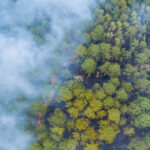Fall foliage is the newest item on the list of concerns about global warming’s impact on the environment, according to a recent article published by NBC News.
Warmer temperatures impact foliage by dulling hues, shortening the season and creating a welcoming environment for invasive species. The foliage industry brings in about $25 billion in revenue for states nationwide.
A study from Harvard Forest conducted over the course of 23 years, concluded that foliage now turns color later on average than when the study began. During this time frame, temperatures increased an average of two degrees throughout the Northeast.
According to ESSIC / AOSC Professor Xin-Zhong Liang, temperature is s the most significant catalyst in determining when leaves will begin to change color in autumn.
“Every plant has a temperature threshold, at which point temperatures become too low for them to continue carrying out production processes. Once deciduous trees hit that threshold, they enter their autumn phase,” said Liang.
Liang noted that the delayed onset of the historic fall temperature thresholds ultimately becomes the deciding factor in the apparent cling to summer by many Northeast trees.
“The problem with warming temperatures is that leaves are “sustaining heat and not experiencing cold enough weather to get them to the threshold where their leaves change color, so the summer season becomes extended,” Liang said.
Interestingly, Liang stated that winter threshold levels have continued to arrive at roughly their historic norms, creating the illusion of a truncated fall, due to the shortened foliage-change -window.
“In reality the temperatures are just not getting cold enough to hit the threshold where leaves change color as early anymore,” Liang said.
Although temperature is the dominant factor in creating this phenomenon, carbon dioxide levels play a role as well, since the warming trend is generally caused by increasing levels of CO2. Liang explained that the trend of increasing CO2 is not something that can be fixed overnight, and will most likely continue to alter season’s cycles.
“Even if temperature has declined in recent years, it’s the long term trend of rising C02 levels and temperature that we need to focus on in order to prevent accelerated climate change. We ask government to control C02, but it will take time to reduce levels,” concluded Liang.
A current Weather Channel foliage indicator for Maryland and other states can be viewed here.





